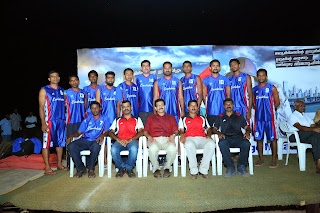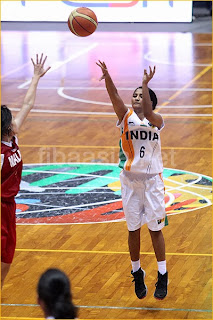With little prior experience or knowledge of the country, Spanish Coach Francisco Garcia was invited to India five months ago to take the hot seat as the Head Coach of India's Women's Senior National side. He didn't have too much time to get acclimitized before the team had to prepare for it's biggest challenge in two years: the
25th FIBA Asia Women's Championship, scheduled in Bangkok from from October 27-November 3. Garcia and his team survived backroom selection drama, a crucial injury, and an aging superstar to head out to Thailand and take on the best teams in Asia.
India were returning to Level I of the competition, which meant that they would have the esteemed privilege of only playing the continent's superpowers in the Preliminary Round - the 'Big Four' of China, Chinese Taipei, Japan, and Korea, with Kazakhstan rounding up the group. India had never won a game in Level I. India lost to the Big Four by large margins, but it was against Kazakhstan where Garcia led the girls to make history. They defeated Kazakhstan in an overtime thriller to win their first ever Level I game, and then defeated Malaysia in a Level I playoff game to
finish at a best-ever fifth place finish.
I caught up with Coach Garcia recently for a candid interview as he reflected on the achievement of his team, shares some of his experiences in India, and looks forward to the future.
Hoopistani: Congrats on the historic 5th place finish in Bangkok. Honestly - was the team surprised at their achievement?
Garcia: Thanks, but as I always say, the coaches are here to help the team and not to act as the heroes. We must try not to disturb the team on and off the court. The real stars of the movie are the players. At the end they worked hard on court and they deserved this performance. I wouldn't say I was surprised, but yes, I was very pleased for the achievement. They know very well all the problems we faced and the short time we had to prepare for this championship. So in that sense, it is a really happy moment.
Hoopistani: How did you celebrate?
Garcia: I'm not a man of big celebrations. I know for India that this is an important achievement. So just knowing that was celebration enough.
Being in Level I, you played only the best teams in Asia. Which team was the toughest challenge?
Garcia: In my view I would say Japan [who were the eventual champions] were the best team. They played very dynamic basketball and had good balance on their side.
Hoopistani: After all the practice and preparation for this tournament, once you got to Thailand, did you have to make any drastic or unexpected change in your tactics?
Garcia: We had the injury of Akanksha Singh one week before the championship, so we had to re-adjust some things in the team. The most important thing was that the roles in the team were well defined and especially, that these roles were accepted by the players.
Hoopistani: Unlike previous years - where India relied mostly on Geethu Anna Jose - this year's team used a slightly more balanced offense (even though Geethu was still the highest scorer). Was this always the plan?
Garcia: I believe that in basketball teams must have balance in the inside and outside game. You are not gonna win by only shooting 3 pointers and neither will you do it playing just close to the basket. The game has moments where your advantage can be inside or outside, and we must be able to read that advantage.
Hoopistani: Which player surprised you most with her performance in Bangkok?
Garcia: I think the key was that we worked as a team, so each player had her moment in the games. All of them were important. Some in defense, some in shooting, and some in rebounding... It was a successful mix.
Hoopistani: How were you able to make sure that the girls don't let their head down after losing the first 4 games by a large margin.
Garcia: This group is mentally tough. We had some big losses in the important games, but they knew to come back strong in the next one. It was very important that they had in mind that our championship really started against Kazakhstan, and other games were there to prepare us for those two last matches.
Hoopistani: The game against Kazakhstan was a classic. You took a big lead, Kazakhstan came back, and the game went to overtime, where India took charge again. What was your favourite memory from that game?
Garcia: Without doubt it was seeing the girls' happiness at the end as they hugged each other on the court. At the end it is their achievement and they fought for it with their hustle and winner's mentality, especially after all the problems we faced in the game.
Hoopistani: How did it feel when the game ended and you had finally led India to their 1st ever Preliminary Round victory?
Garcia: It's always a special feeling when you make history in a country. So we felt really proud for some time. We could not forget that the championship was not over and the game against Malaysia was looming. If we lost that game then nothing we did against Kazakhstan would've counted
Hoopistani: Looking ahead, who do you think will replace the hole in the middle if and when Geethu finally moves on from the national team?
Garcia: Looking at the future, I think this country must put the focus on working hard continously with the younger kids, because they are future. People are needed here [in India] who work for basketball and leave aside their power hunger and their egos. When you work for your country and the national team, you must put your ego towards the country and the team's service. Not the opposite. Better investment in players is needed. India are number 5 in Asia, and believe me, many countries would love to be in that position, especially the ones with professional leagues. A professional league is urgently needed in India, plus they need to have exposure trips for players to get some more experience. The biggest mistake now after this achievement would be to be content and not to put in the right tools to keep growing.
Hoopistani: How has your experience been so far, working in India
Garcia: It's been pretty interesting. We've had no problems on the court. The girls have been open to all the things I have been explaining. But there were some selection problems in trying to construct the team. I just think that we should have more unity in the selection process.
Hoopistani: How long will you be in India?
Garcia: I have contract until June 2015, but after June 2014 I can re-negotiate. Right now, we're trying to build a good programme here. If things go the right way, I have no problem staying here longer. For now, I am here, and we need to make some progress in basketball.
Hoopistani: Do you think India can break into Asia's big four - China, Chinese Taipei, Japan, Korea? If so, how can they do it?
Garcia: In these countries basketball is the first or the second sport, so it is not easy to get close to them. Professional leagues, proper training, better facilities... If you want to get closer to the big four, you must build a reasonable working line from the grassroots with the goal of preparing players for the senior team. Obviously, many things must change. In general, unfortunately, basketball on court is secondary in India. In my stay here I have been quite disappointed with some mentalities at the human and professional level. So if you want to grow you first need the unity to work properly and clear the mind to focus on basketball.
Hoopistani: Off the court, have you had any interesting experiences in India so far?
Garcia: Well for me, on the first day I was here, I saw people eating food with their hands, and I was a little shocked! Now, after five months, I find myself doing it too, and I'm getting used to it.
Hoopistani: So what Indian food do you like?
Garcia: I really like to eat biryani, Chicken Tikka Masala, and Gulab Jamun. And whenever I need the urge to eat food from my home country, I have found a Spanish restaurant in New Delhi which I have tried a few times.





















